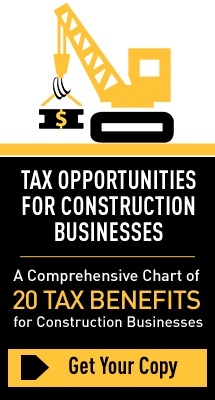 As you may know, contractors have multiple accounting methods to choose from. But some are off-limits to certain contractors. As your construction company endures the ups and downs of a bumpy industry, it's worth your while to review your options.
As you may know, contractors have multiple accounting methods to choose from. But some are off-limits to certain contractors. As your construction company endures the ups and downs of a bumpy industry, it's worth your while to review your options.
The Cash Method
The rules here are simple: Count income when you receive it, and deduct expenses when you pay them. Receiving income means having unrestricted access to the money you earned. For example, if a customer sent you a check in July but you didn't deposit it until August, you still received it in July for accounting purposes.
Although some contractors use this method for general accounting, many contractors can't use it for tax purposes. If your business has more than $25 million in average annual gross receipts (AGR) (an increase from the previous threshold of $5 million), you can't use this method.
Consult your tax advisor on situations where a percentage-of-completion and/or completed contract method have historically been used.
The Accrual Method
 This approach attempts to match up expenses and revenues from specific contracts, making it more helpful for determining job profitability than the cash method. Contractors who can't use the cash method should use the accrual method for overall expenses and short-term contracts.
This approach attempts to match up expenses and revenues from specific contracts, making it more helpful for determining job profitability than the cash method. Contractors who can't use the cash method should use the accrual method for overall expenses and short-term contracts.
Small construction businesses can also use the accrual method for long-term contracts that will take less than two years to complete. The IRS defines a "small" construction company as one having $25 million or less in AGR for the past three years. A company with more than $25 million in AGR is considered a "large" business.
Under the accrual method, you count income as soon as you've established your right to receive it. That may mean you've earned it by completing a project satisfactorily, billed the customer or received payment for the work. But, in some cases, this method may require you to declare your income before you've received the money.
The accrual method requires you to deduct expenses when you receive the merchandise or services or when you determine the expense's cost, whichever is later. If you pay an expense that benefits you in multiple years, you must spread the cost across all years.
READ MORE: New Tax Reform Rules Include Big Benefits for Construction Companies
Long-Term Contracts
Long-term contracts, which are contracts that span more than one tax year, require special accounting.
Long-term accounting methods generally require you to allocate job costs to the appropriate contracts. Job costs include direct costs, such as wages and labor, and indirect costs, such as equipment and utilities.
The indirect costs you allocate to contracts vary depending on whether you're a large or small construction business, so check with your tax advisor. Here's a breakdown of the two most common long-term contract accounting methods:
Percentage-of-completion: This requires you to report income and expenses for each year of a multiyear contract. Large construction companies must use this method for all long-term contracts, and small ones must use it for contracts that last two years or longer. Many lenders and sureties also require contractors to use this method.
To determine how much income to report for each contract, calculate your project completion factor by dividing deductible project costs for that year by the total estimated cost to complete the project. For example, if you spent $250,000 on a project that will cost $1 million to complete, your contract is 25% complete. Multiply that factor by the contract's total value to determine how much income to report, a figure that may be different from the amount you've billed your project owner.
Completed-contract: Under this approach, you report all the income from a contract and deduct all the expenses in the year the job is complete. Small construction companies may use this method for long-term contracts shorter than two years.
Although the completed-contract method allows you to defer taxes on your income, it prevents you from deducting losses on unprofitable jobs until the contract ends. Plus, it can push you into a higher tax bracket by bunching income into one year.
READ MORE: Construction Accounting 101: Top Deductions, Accounting Methods
Don't Forget to Look Back
If you have a long-term contract, your work isn't done when the project's complete. Contractors who use the percentage-of-completion method need to "look back" when the contract is done.
Doing so determines whether the taxes you paid for each year of your contract were higher or lower than they would have been if you'd used actual figures to calculate your taxes instead of estimates. But looking back doesn't change the amount of tax you owe. Instead, you pay interest on the difference in tax if you underpaid, and the IRS refunds interest to you if you overpaid.
You don't need to look back at home construction contracts and certain other small contracts. Small construction companies (those having $25 million or less in annual gross receipts for the past three years) may also skip looking back for jobs that last less than two years. In addition, you can choose not to look back if the actual contract income and costs are within 10% of the figures reported for each contract year.
Find What Works for You
Failing to play by the book when it comes to your accounting method can cause the IRS to blow a whistle or trip up your efforts to obtain bonding or a loan. To ensure that you're not at risk and that you're using the method that benefits you the most, revisit this topic regularly with your CPA or contact us for personalized assistance.
© 2018





